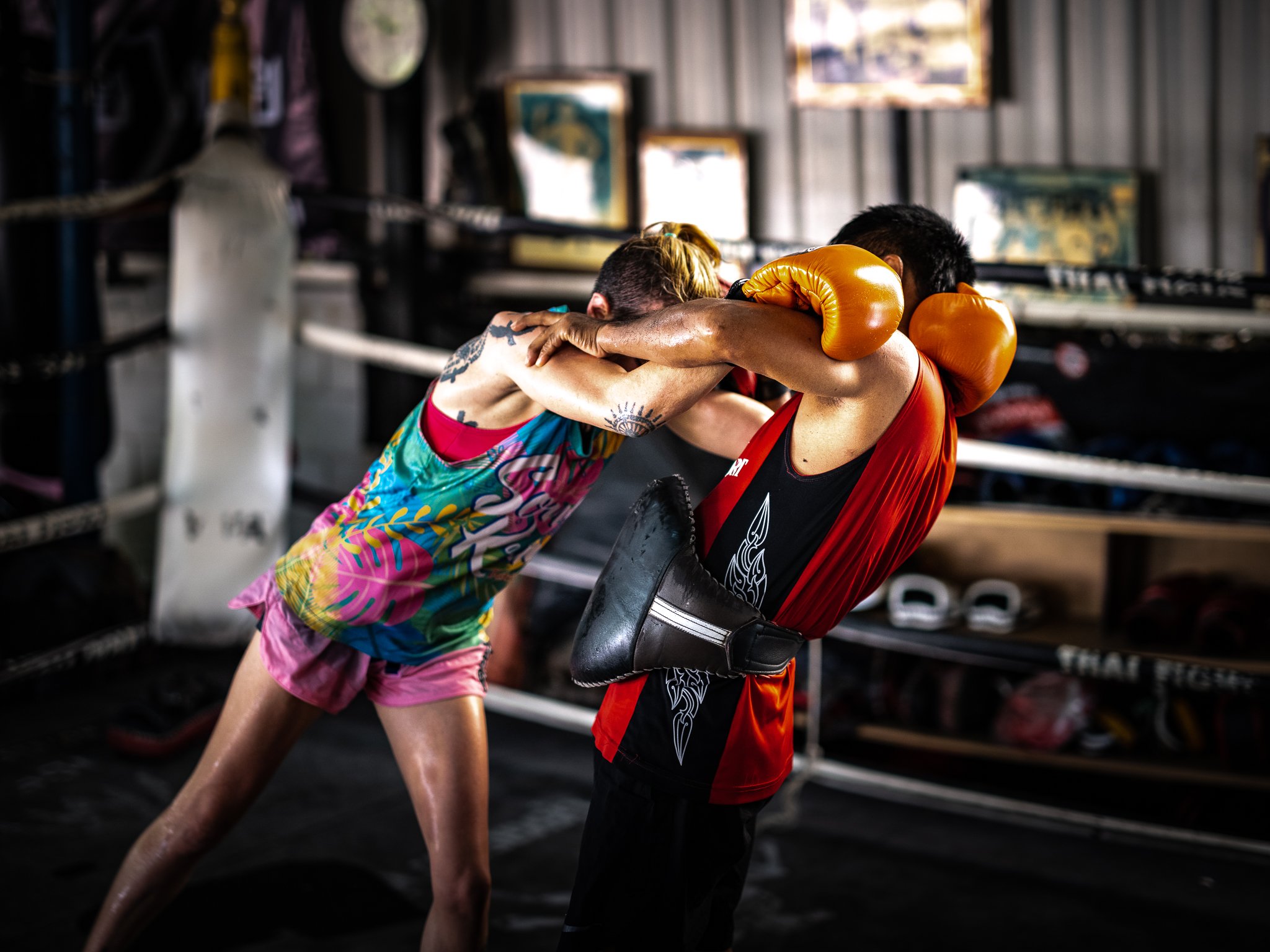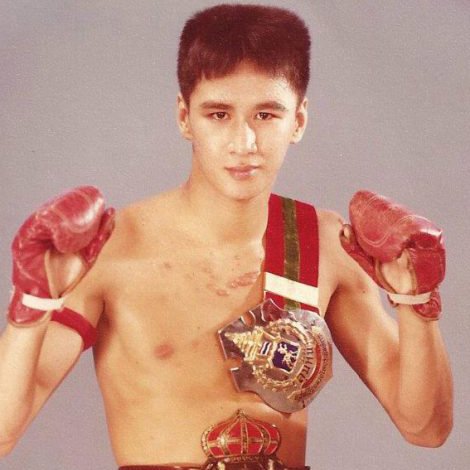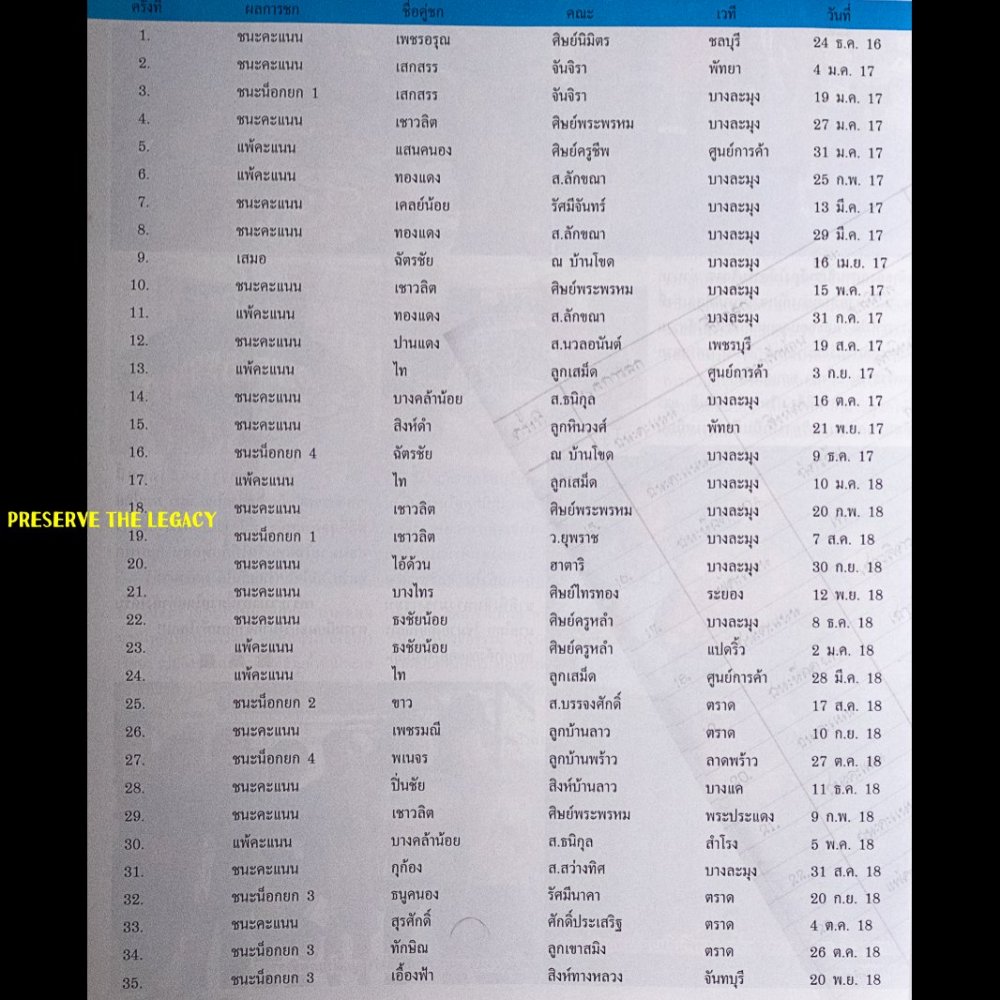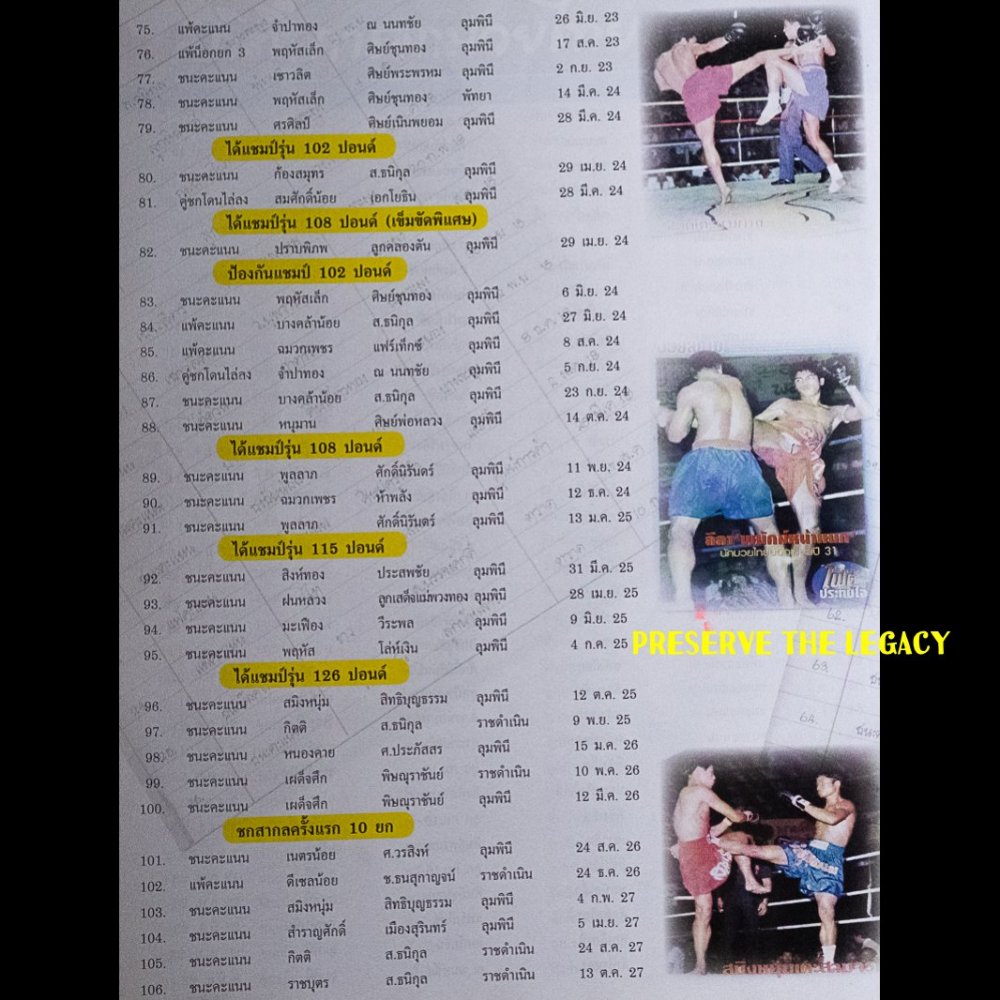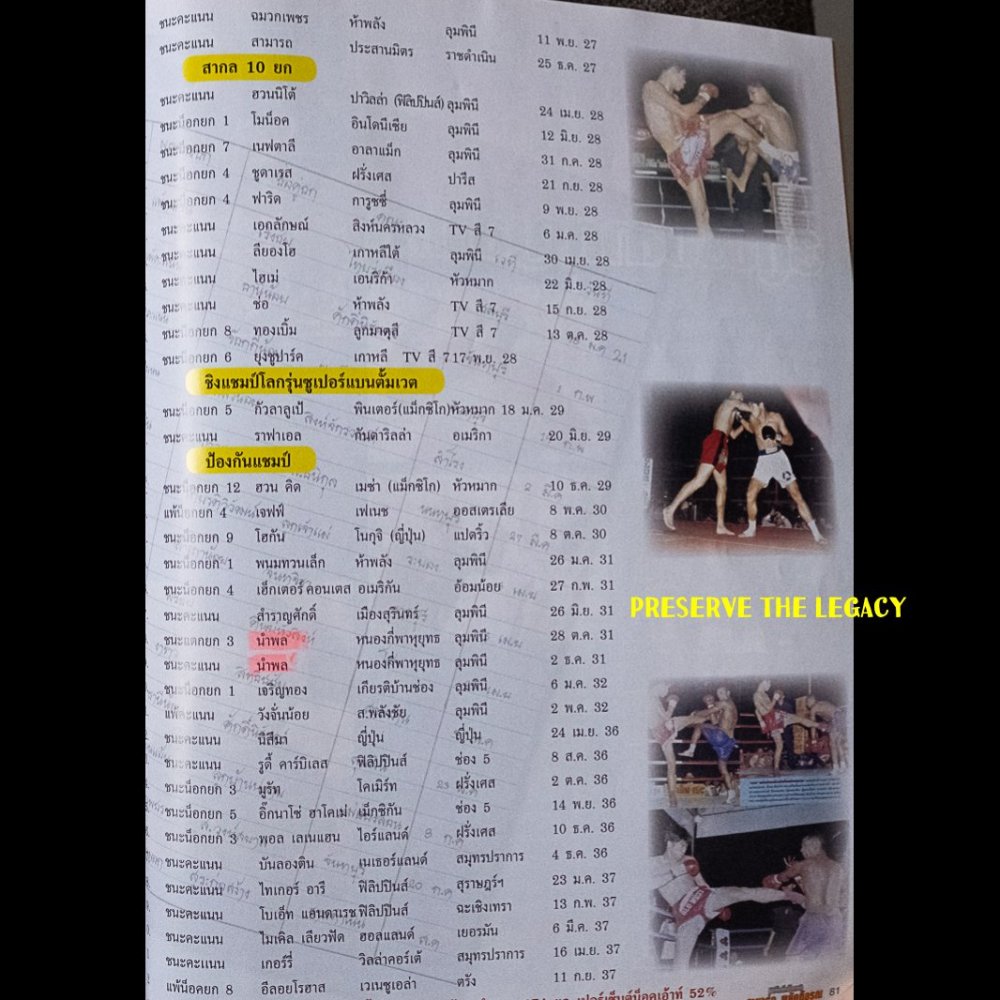-
Posts
1,191 -
Joined
-
Days Won
388
Everything posted by Sylvie von Duuglas-Ittu
-

Muay Thai visa
Sylvie von Duuglas-Ittu replied to DrunkenMaster's topic in Gym Advice and Experiences
The Bangkok location of Fairtex has been closed for a number of years now, they're only in Pattaya. Master Toddy's has a Muay Thai visa, WKO in Pattaya has one that can go for 5 years, The Camp in Chiang Mai offers one but it's technically an ED visa for Thai Language, but arranged through the gym.- 1 reply
-
- 2
-

-

-
Thanks for linking the thread @LengLeng. Definitely check that out for answers, but the shortest version is that I think concussions should be taken quite seriously and I've been lucky to not have experienced them (to my knowledge) frequently. I had one really bad one and took a full 10 days (I think... check the thread) rest. And I was recently concussed again and took less rest, but my diet is very different now and I think that makes a huge difference.
-
I've never been injured by my trainers, but I've had this shit-just-got-very-real experience of emotional rise and physical amplification to drive/meet it. It's scary. I'm sorry for your experience of it, but I've also learned from the experience and it's not all mistakes and terror. I don't know the culture where you are now, but in Thailand (where you know the culture) talking about it isn't a thing. There was a kind of acknowledgment of it, a few words to make sure that we both understood what happened, and that was that. Being bashed in the head like that is much worse than I've ever experienced, but learning to control emotion - including someone else's emotion - is part of the whole game, unfortunately... and fortunately. I hope your head is okay and that the relationship in the gym space is manageable.
-

Rhythm
Sylvie von Duuglas-Ittu replied to Jim's topic in Muay Thai Technique, Training and Fighting Questions
Like most things, it's imitative until it's natural. Maybe mimic someone you like for a bit until something clicks, but then just find your beat and go with it. It's like dancing. You can steal choreography for a while, but then you have to actually hit the beats and feel the music for yourself. I find tire bouncing and shadow most helpful for this, personally. -
I'm so glad you enjoyed that session. I adore Kaensak so much and it was really a huge and meaningful thing for me personally to be able to get him in the library. He's kind of a bridge between Yodmuay and the West, because he was such a great fighter but has spent so much time teaching in the US by now that he has altered how he explains or teaches (or at least I imagine it's been hugely influenced), so it's digestible for us in this format.
-
Yeah, you're going to have to keep them as clean as possible, first and foremost. Floors are disgusting and feet are on them all the time. The advice I got from Andy Thomson when I first shredded the hell out of my feet in Thailand was to put Vaseline or coconut oil on the torn skin before bed, let it soak in and keep that skin soft. If it's rough, it'll get caught on things and keep tearing the softer skin at its edges. So keep that skin as soft as possible. And you can trim the flaps of skin to keep them from snagging. Taping the area can work, but you have to make sure you put something between the blister and the tape so that you're not ripping the skin off when you take the tape off. So always put some gauze or toilet paper or tissue, whatever, between the sticky tape and your skin. Blisters suck. But they're a totally normal part of training for a long time, and then after you build up callouses it's not as persistent, but it does arise.
-
Yeah, I'm not sure what to add to what Kevin said, since he's speaking from our shared experience with this. I'd say pay very close attention to any symptoms that might develop after the fact and, even if you don't have dizziness, fogginess, headaches, or anything like that to still be very cautious in resuming anything that rattles your brain. So, no sparring with head punches and see whether or not hitting a heavy-bag causes any kind of discomfort to that area of your head (from the impact, obviously not from contact). Maybe increase Omega 3 fats in your diet to help your brain heal as well, knowing that it took a shock even if you don't have any concussion symptoms.
-
I've noted recently this combination of finesse and venom in the way the "Top 5" lists are defended by the incredible fighters who are listing them. Samart has such beautiful technique, he has everything, he could fight both Muay Thai and Boxing (interestingly, he had way more KOs in boxing than in Muay Thai). Dieselnoi was powerful, but he also had all the weapons, he had an array of knees. It's the combination that puts them at the top. Others are kind of mentioned as excelling at the art aspect; none are awarded a top slot for power alone. But it's the combination that is what makes the best the best, it seems. I also maybe don't know how much my own thoughts influence how I hear this, but in the praise of "ning" fighters it's that they LOOK unaffected, not that they ARE unaffected. The "oi" that is called out from the crowd is proof of the power of a fighter, regardless of what the response of the opponent is. We believe it hurts, but if the opponent acts like it doesn't, we believe his supernatural powers.
-
The Thai news right now is suggesting June 15th. Obviously that's not written in ink in any way at all and the government here changes things all the time and last minute. There are talks of promotions at Lumpinee and Rajadamnern beginning the weekend after the 15th of June, which means it will be televised but with no audience. They call it "the New Normal." It's the same date as opening gyms, which makes no sense at all. Some things are opening up earlier than was previously projected (malls, for example). Muay Thai is a big market in terms of tourism, so they certainly want them open, but it will also hinge on when international travel is opened up again. Lots of variables. But as of this moment, June 15th is the projection.
-
Years 1980-1982 translated in this article 1980 February 11- Kongsamut Sor Thanikul, Lumpinee (win, points) wins the 102 lb Lumpine belt March 14 - Parahatlek Sitchuntong, Pattaya (win points) March 28 - Sonsil Sit Nernpayong, Lumpinee (win points) April 29 - Gongsamut Sor Thanikul, Lumpinee (win points) March 28 (sic) - Somsaknoi Aekyotin, Lumpinee (opponent/fight cancelled) April 29 (sic) - Prappirpop Lookklangdon, Lumpinee (win, points) June 6 - Parahatlek Sitchuntong, Lumpinee (win, points) June 27 - Bangklanoi Sor. Thanikul, Lumpinee (loss, points) August 8 - Chamuakpet Fairtex, Lumpinee (loss, points) - loses the 102 lb Lumpinee Belt September 5 - Jampatong Dornontachai, Lumpinee (opponent/fight cancelled) September 23 - Bangklanoi Sor. Thanikul, Lumpinee (win, points) October 14 - Numan Sit Pohluang, Lumpinee (win, points) November 11 - Punlap Sit Niran, Lumpinee (win, points) - 108 lb Lumpinee belt December 12 - Chamuakpet Hapalang, Lumpinee (win, points) 1981 January 13 - Punlap Sit Niran, Lumpinee (win, points) March 31 - Singtong Prasopchai, Lumpinee (win, points) - wins 115 lb Lumpinee belt April 28 - Fanluang Looksadejmaepuangtong, Lumpinee (win, points) - it would be voted the Fight of the Year June 9 - Mafuang Weerapol, Lumpinee (win, points) September 4 - Paruhat Lohngern, Lumpinee (win, points) October 12 - Samingnoom Sit Boondam, Lumpinee (win, points), wins 126 lbs Lumpinee belt November 9 - Gitti Sor. Thanikul, Rajadamnern (win, points) 1982 January 15 - Nongkhai Sor Prahpatson, Lumpinee (win, points) March 12 - Padejsuk Pitsanurachan, Rajadamnern (win, points) May 10 - Padejsuk Pitsanurachan, Rajadamnern (win, points) August 24 - Netnoi Sor Wansing, Lumpinee (win, points) - his first pro boxing fight December 24 - Dieselnoi Chor Thanasukarn (loss, points)
-

Going to thailand for 3 months
Sylvie von Duuglas-Ittu replied to Nadiyaz's topic in Gym Advice and Experiences
Overestimate your food budget where you can. I've seen tons of people come to Thailand with the 30Baht/meal expense of living off of chicken rice and they can't handle that for longer than a week. They end up splurging on expensive western food to get a "break" and it kills their budget. Have a budget, but factor in that you'll want a break from the cheap options as well.- 17 replies
-
- chiang mai
- thailand
-
(and 1 more)
Tagged with:
-

Training App
Sylvie von Duuglas-Ittu replied to Mikasa's topic in Muay Thai Technique, Training and Fighting Questions
Thanks for sharing this. -
Just as a part of history and reference, this was a published career fight record for Samart Payakaroon, photographed. You can see my translation of the years 1980-1982 available to the public, on my Patreon. These are hi-res photos so you should be able to zoom in. There are some errors in dates in this published version, I believe, maybe typos.
-
There aren't a lot of books or films directly about Muay Thai, the mental game for Muay Thai, the fighter's journey or all that. There are more options for other sports that have either been around for longer (Golf, Tennis, Running), or that have an English-speaking target audience (ultra-running, rock climbing). However, I find some sports very, very inspiring for Muay Thai and what the mental side of it feels like - to me anyway. Here's my running list of books and films: Rock Climbing: Free Solo: Marathon Monks of Mt Hiei: Momentum Generation The Rise of Superman: Decoding the Science of Ultimate Human Performance A Wrestling Life: the Inspiring Stories of Dan Gable
-
I can't think of anything that would work really well without something to kick, either a bag or a pad. For a middle kick, just kicking all the way to a 180 turn, then another to get back to where you started. I do this in one of my live streams from my At Home workouts. But with or without a pad/bag, the thing about high repetition is the high repetition. So anything you can do hundreds of would ultimately help with your balance and form, over the long run. You could prop your leg up on something that's the same height as your middle kick and then just practice the arms, twist and rise up on the foot, hundreds of times. Or put a pillow against the sofa and mimic the step over and kick of a low kick, steady and without power, hundreds of times.
-
Thanks for watching the live streams and for using the forum, for exactly what it's for! There are a few places offering online training. Por Promin in Hua Hin has been offering this and I imagine they'd have a pretty good method going by now; they have English, are used to training all levels, and already have the sessions going. Here's their FB: https://web.facebook.com/porpromin/ Santai has said that their offering PT, as well as free technique live videos on their FB periodically. Here's their FB, and you can ask about privates. I recommend Kru Ten. https://web.facebook.com/muay.thai.gym/
-
Richard, you're in my hometown! I was going to suggest that if you get a standing bag, one that has a base, that you can fill it with water because then you can empty it and move it more easily than if it's sand. But because of all the snow and change in temperatures that Boulder experiences, the water might be a risky move. A hanging bag is preferable for all kinds of reasons, but obviously depends on budget and if you have somewhere to hang it from. Leather cracks if you don't fill the bag properly at the beginning. Any slack, "bagginess" between the filling and the leather, if you hit it for a few weeks it will crack and break open. So make sure you really pack it and keep adding to it over the first couple weeks to make sure it's full, even as the filling starts to settle. I'm looking at everyone's gyms and am jealous of these mats. Kevin and I are working on tile and it's very slippery when we start to drip from sweat and I think I hurt my foot by stomping around like a maniac on such a hard surface... I thought I was tougher, I guess.
-
Ruup is literally the body as an object. Picture a doll, how it's posed, how it's positioned, posture, overall composure. It's physical. Ning is something that can be expressed through posture, but it's not the posture itself. It's being unmoved, unbothered, unaffected. If you get kneed in the guts and your body folds, your Ruup broke, but if you just carry on as if it doesn't matter and you keep coming, that's Ning.
-
The benefit to the chest strap is that you can take the watch part off your wrist and just keep it close by for bagwork. Like, wrap it around the leg of a chair within range of it still reading your heart rate. If you have only the wristband, you have to keep it on your wrist under your glove for it to continue reading your heart during those workouts. I don't like that. Kevin doesn't seem to mind at all. Depends on your own preference but that's what I consider between the two.
-
I was about to bring up Ali in that first fight against Frazier as well. I don't know how Jiu Jitzu is judged, ultimately, so I can't say how looking tired would affect the impression you're giving to judges. In a 1-1 interaction with your opponent, maybe you can get the effect you're talking about that was in that Frazier/Ali fight, where he seemed to kind of dishearten Frazier a little bit by looking ready to go and then not being able to be knocked out... but I've never personally been one to be impressed in any sort of way by someone looking tired, even if they continue all through.
-
I think this is especially tricky because of the complete disparity between importance and commonality of fighting between Thai gyms and western gyms. In the argument about grading systems in western gyms, which is a way to retain members and give people who aren't fighters a sense of accomplishment and progress, these methods are in place because gyms are not mainly fighter's gyms. Most members are there for fitness or passion, but most won't fight. There are "fight teams" within the gyms and the more fighters you have the more "authentic" you are, I guess. But in Thailand, a grading system would be ridiculous. You walk into a gym and just watch people and you know what "level" they are in experience. Fighters definitely have importance for financial reasons and giving "face" and esteem to the gym name, which is true in the West as well but to a very, very different degree. I'm not sure how that kind of "authenticity" could translate into such a different system in the West, with such different business models, customer breakdowns, opportunities, and most importantly a broad disparity in experience between Thai trainers/gyms and those anywhere else in the world.
Footer title
This content can be configured within your theme settings in your ACP. You can add any HTML including images, paragraphs and lists.
Footer title
This content can be configured within your theme settings in your ACP. You can add any HTML including images, paragraphs and lists.
Footer title
This content can be configured within your theme settings in your ACP. You can add any HTML including images, paragraphs and lists.
